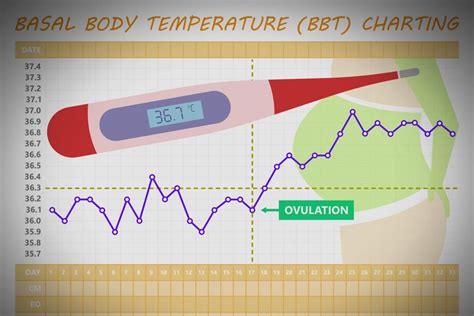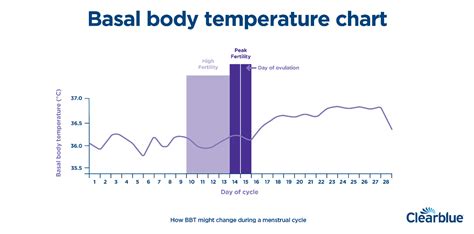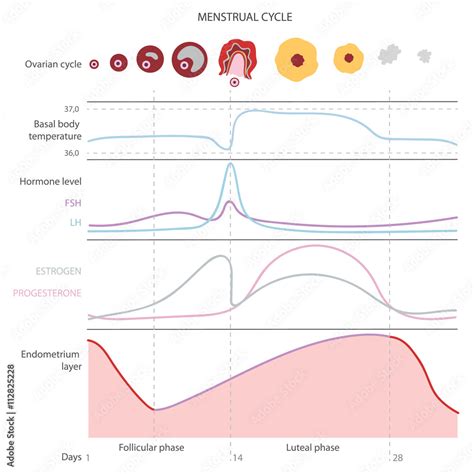Intro
Learn about Basal Body Temperature, a key fertility indicator, and how it relates to menstrual cycles, ovulation, and pregnancy, with tips on tracking and interpreting BBT charts for natural family planning and reproductive health.
Basal body temperature, often abbreviated as BBT, is a crucial aspect of human physiology that has garnered significant attention in recent years, particularly among individuals trying to conceive or monitor their reproductive health. The importance of basal body temperature lies in its ability to provide valuable insights into the body's hormonal balance, ovulation, and overall fertility. By understanding and tracking basal body temperature, individuals can gain a deeper understanding of their bodily functions, making informed decisions about their health and wellness. In this article, we will delve into the world of basal body temperature, exploring its significance, benefits, and practical applications.
Basal body temperature is the lowest body temperature recorded during rest, typically measured immediately after waking up and before engaging in any physical activity. This temperature is influenced by various hormonal fluctuations throughout the menstrual cycle, making it an excellent indicator of ovulation and fertility. By monitoring basal body temperature, individuals can identify patterns and changes in their body, allowing them to better understand their reproductive health and make informed decisions about family planning. Moreover, basal body temperature can also serve as an indicator of overall health, as certain temperature fluctuations may signal underlying medical conditions.
The concept of basal body temperature has been around for decades, with researchers and healthcare professionals recognizing its potential as a non-invasive and cost-effective method for monitoring reproductive health. With the advent of digital thermometers and mobile apps, tracking basal body temperature has become more accessible and convenient than ever. Individuals can now easily monitor their temperature and receive personalized insights, empowering them to take control of their health and wellness. As we explore the world of basal body temperature, it becomes clear that this simple yet powerful tool has the potential to revolutionize the way we approach reproductive health and family planning.
Understanding Basal Body Temperature

To comprehend the concept of basal body temperature, it is essential to understand the physiological processes that influence it. During the menstrual cycle, hormonal fluctuations cause changes in body temperature, with estrogen and progesterone playing a crucial role. Estrogen levels typically dominate during the first half of the cycle, causing a decrease in body temperature. As ovulation approaches, progesterone levels surge, leading to a slight increase in temperature. By monitoring these temperature changes, individuals can identify when ovulation occurs, making it an effective method for timing intercourse and increasing the chances of conception.
Benefits of Tracking Basal Body Temperature
The benefits of tracking basal body temperature are numerous, ranging from improved fertility awareness to enhanced overall health. Some of the most significant advantages include: * Increased fertility awareness: By monitoring basal body temperature, individuals can identify their most fertile days, making it easier to conceive. * Improved reproductive health: Tracking basal body temperature can help individuals detect underlying reproductive issues, such as polycystic ovary syndrome (PCOS) or thyroid disorders. * Enhanced overall health: Basal body temperature can serve as an indicator of overall health, with certain temperature fluctuations signaling underlying medical conditions. * Non-invasive and cost-effective: Tracking basal body temperature is a non-invasive and cost-effective method for monitoring reproductive health, making it an attractive option for individuals seeking a natural approach to family planning.How to Track Basal Body Temperature
Tracking basal body temperature is a straightforward process that requires minimal equipment and effort. To get started, individuals will need a digital thermometer, preferably one designed specifically for basal body temperature tracking. It is essential to follow a consistent routine, taking temperature readings at the same time every day, immediately after waking up and before engaging in any physical activity. Here are some tips for tracking basal body temperature:
- Use a digital thermometer: Digital thermometers provide accurate readings and are easy to use.
- Establish a routine: Take temperature readings at the same time every day, ideally immediately after waking up.
- Record readings: Keep a record of temperature readings, either manually or using a mobile app.
- Look for patterns: Identify patterns and changes in temperature readings, which can indicate ovulation and fertility.
Common Mistakes to Avoid
When tracking basal body temperature, it is essential to avoid common mistakes that can affect the accuracy of readings. Some of the most common mistakes include: * Inconsistent routine: Failing to take temperature readings at the same time every day can lead to inaccurate results. * Poor thermometer quality: Using a low-quality thermometer can result in inaccurate readings. * Failure to record readings: Not keeping a record of temperature readings can make it challenging to identify patterns and changes.Interpreting Basal Body Temperature Charts

Interpreting basal body temperature charts requires a basic understanding of the physiological processes that influence temperature fluctuations. A typical basal body temperature chart will show a dip in temperature during the first half of the menstrual cycle, followed by a surge in temperature after ovulation. By analyzing these charts, individuals can identify patterns and changes in their body, making it easier to time intercourse and increase the chances of conception. Here are some tips for interpreting basal body temperature charts:
- Look for the temperature shift: Identify the temperature shift that occurs after ovulation, which is typically characterized by a 0.4-1.0°F (0.2-0.5°C) increase in temperature.
- Identify the fertile window: The fertile window typically occurs 5-7 days before ovulation, during which time intercourse is most likely to result in conception.
- Monitor temperature fluctuations: Keep an eye on temperature fluctuations, which can indicate underlying reproductive issues or other medical conditions.
Basal Body Temperature and Fertility
Basal body temperature is closely linked to fertility, with temperature fluctuations providing valuable insights into ovulation and reproductive health. By monitoring basal body temperature, individuals can identify their most fertile days, making it easier to conceive. Here are some ways basal body temperature can impact fertility: * Timing intercourse: By identifying the fertile window, individuals can time intercourse to coincide with their most fertile days, increasing the chances of conception. * Detecting underlying issues: Basal body temperature can serve as an indicator of underlying reproductive issues, such as PCOS or thyroid disorders, which can affect fertility. * Enhancing overall health: By monitoring basal body temperature, individuals can identify areas for improvement in their overall health, which can positively impact fertility.Basal Body Temperature and Overall Health

Basal body temperature is not only linked to reproductive health but also provides valuable insights into overall health. Certain temperature fluctuations can signal underlying medical conditions, such as hypothyroidism or anemia. By monitoring basal body temperature, individuals can identify areas for improvement in their overall health, making it an essential tool for maintaining wellness. Here are some ways basal body temperature can impact overall health:
- Detecting underlying conditions: Basal body temperature can serve as an indicator of underlying medical conditions, such as hypothyroidism or anemia.
- Monitoring inflammation: Basal body temperature can provide insights into inflammation levels, which can impact overall health.
- Enhancing immune function: By monitoring basal body temperature, individuals can identify areas for improvement in their immune function, which can positively impact overall health.
Common Basal Body Temperature Ranges
Basal body temperature can vary from person to person, with typical ranges falling between 97.0-97.7°F (36.1-36.5°C) before ovulation and 97.7-98.3°F (36.5-36.8°C) after ovulation. Here are some common basal body temperature ranges: * Pre-ovulatory range: 97.0-97.7°F (36.1-36.5°C) * Post-ovulatory range: 97.7-98.3°F (36.5-36.8°C) * Menstrual range: 96.8-97.2°F (36.0-36.2°C)Basal Body Temperature and Menstrual Cycle

Basal body temperature is closely linked to the menstrual cycle, with temperature fluctuations providing valuable insights into ovulation and fertility. By monitoring basal body temperature, individuals can identify their most fertile days, making it easier to conceive. Here are some ways basal body temperature can impact the menstrual cycle:
- Identifying ovulation: Basal body temperature can help individuals identify ovulation, which is essential for timing intercourse and increasing the chances of conception.
- Monitoring hormonal fluctuations: Basal body temperature can provide insights into hormonal fluctuations throughout the menstrual cycle, which can impact fertility and overall health.
- Enhancing fertility awareness: By monitoring basal body temperature, individuals can gain a deeper understanding of their reproductive health, making it easier to make informed decisions about family planning.
Basal Body Temperature and Pregnancy
Basal body temperature can also provide valuable insights into pregnancy, with certain temperature fluctuations signaling implantation or other pregnancy-related changes. Here are some ways basal body temperature can impact pregnancy: * Identifying implantation: Basal body temperature can help individuals identify implantation, which typically occurs 6-10 days after ovulation. * Monitoring pregnancy health: Basal body temperature can provide insights into pregnancy health, with certain temperature fluctuations signaling underlying issues. * Enhancing prenatal care: By monitoring basal body temperature, individuals can gain a deeper understanding of their pregnancy, making it easier to make informed decisions about prenatal care.What is basal body temperature?
+Basal body temperature is the lowest body temperature recorded during rest, typically measured immediately after waking up and before engaging in any physical activity.
How do I track basal body temperature?
+To track basal body temperature, use a digital thermometer and take readings at the same time every day, ideally immediately after waking up. Record readings and look for patterns and changes in temperature.
What are the benefits of tracking basal body temperature?
+The benefits of tracking basal body temperature include increased fertility awareness, improved reproductive health, and enhanced overall health. It can also serve as an indicator of underlying medical conditions.
How does basal body temperature impact fertility?
+Basal body temperature can impact fertility by providing valuable insights into ovulation and reproductive health. By monitoring basal body temperature, individuals can identify their most fertile days, making it easier to conceive.
Can basal body temperature indicate underlying medical conditions?
+Yes, basal body temperature can serve as an indicator of underlying medical conditions, such as hypothyroidism or anemia. Certain temperature fluctuations can signal underlying issues, making it essential to monitor basal body temperature regularly.
As we conclude our exploration of basal body temperature, it becomes clear that this simple yet powerful tool has the potential to revolutionize the way we approach reproductive health and family planning. By understanding and tracking basal body temperature, individuals can gain a deeper understanding of their bodily functions, making informed decisions about their health and wellness. We invite you to share your thoughts and experiences with basal body temperature, and to explore the many resources available for tracking and interpreting this vital sign. Whether you are trying to conceive, monitor your reproductive health, or simply take control of your overall wellness, basal body temperature is an essential tool to have in your arsenal.
